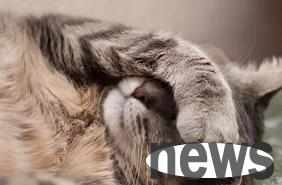The appearance of cataracts will greatly affect the vision of the cat's eyes (or unilateral eyes). At first, it only sees a layer of milky white turbidity on the surface of the pupil. Slowly it will prevent light from entering the retina, which will eventually lead to vision loss or even blindness. In addition, the appearance of cataracts can also cause stress, irritation and other discomforts for cats.
Usually, we will link cataracts and aging, especially elderly cats over 7 years old are more likely to suffer from this disease. However, age is only one of the causes of cataracts. Even newborn cats may suffer from cataracts. This abnormality is called "congenital cataracts" and more common causes such as eye trauma, infection, inflammation, and malnutrition (kittens).

Symptoms of cataracts
The main symptoms of cataracts depend on the extent of their vision impairment. For example, in the early stages of illness, the cat's vision impairment is usually less than 30%. This level of vision changes will not make the cat feel any change, because they can still use other senses to make up for this deficiency, such as smell and hearing. Moreover, during this period, there will be no ice-blue spots or complete crystallization (turbidity) in the cat's pupils.
Basically, when we find out, the cat's pupils have long been ice-blue or completely crystallized (turbid). Over time, they create crystal cracks that look like patterns on marble and start to act abnormally. (Just like we look at the world through a frosted glass) The treatment and prevention of cataracts in cataracts depends on the cause. The general purpose of treatment is not to restore vision, but to prevent secondary problems such as uveitis, glaucoma, and retinal detachment.
The only way is to remove them completely by surgery; nonetheless, there are other ways to prevent the condition from worsening.
The veterinarian may prescribe eye drops to prevent inflammation and secondary complications. If cataracts are a result of malnutrition, the veterinarian may tell you to adjust your cat’s diet. There are many types of surgery for cataract removal.
Phoemulsification is a process of liquefaction of lenses with ultrasonic waves and replacing liquids with an equilibrated salt solution. There is a 90% success rate in cats. An intraocular lens can be implanted during surgery to prevent hyperopia.
Other forms of surgery include extracapsular lens removal and intracapsular lens removal.
Prevention is the best medicine. The best option is to prevent cataracts by reducing exposure to the causes of cataracts. Keeping up to date vaccinations can help prevent viral infections from affecting the lens of the eyes.
Maintaining a proper diet from childhood to avoid exposure to toxic substances is also of great help in preventing the development of cataracts.
Because many cataracts are formed due to eye injuries, prevent cats from fighting with other cats to avoid eye injuries.